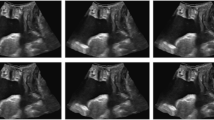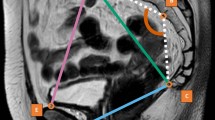Abstract
Transperineal volumetric ultrasound (US) imaging has become routine practice for diagnosing pelvic floor disease (PFD). Hereto, clinical guidelines stipulate to make measurements in an anatomically defined 2D plane within a 3D volume, the so-called C-plane. This task is currently performed manually in clinical practice, which is labour-intensive and requires expert knowledge of pelvic floor anatomy, as no computer-aided C-plane method exists. To automate this process, we propose a novel, guideline-driven approach for automatic detection of the C-plane. The method uses a convolutional neural network (CNN) to identify extreme coordinates of the symphysis pubis and levator ani muscle (which define the C-plane) directly via landmark regression. The C-plane is identified in a postprocessing step. When evaluated on 100 US volumes, our best performing method (multi-task regression with UNet) achieved a mean error of 6.05 mm and 4.81\(^{\circ }\) and took 20 s. Two experts blindly evaluated the quality of the automatically detected planes and manually defined the (gold standard) C-plane in terms of their clinical diagnostic quality. We show that the proposed method performs comparably to the manual definition. The automatic method reduces the average time to detect the C-plane by 100 s and reduces the need for high-level expertise in PFD US assessment.
Access this chapter
Tax calculation will be finalised at checkout
Purchases are for personal use only
Similar content being viewed by others
References
AIUM/IUGA practice parameter for the performance of urogynecological ultrasound examinations: developed in collaboration with the ACR, the AUGS, the AUA, and the SRU. J. Ultrasound Med. 38(4), 851–864 (2019)
Bonmati, E., et al.: Automatic segmentation method of pelvic floor levator hiatus in ultrasound using a self-normalising neural network. J. Med. Imaging 5, 12 (2017)
Cattani, L., et al.: Exo-anal imaging of the anal sphincter: a comparison between introital and transperineal image acquisition. Int. Urogynecology J. 31(6), 1107–1113 (2019). https://doi.org/10.1007/s00192-019-04122-5
Chykeyuk, K., Yaqub, M., Alison Noble, J.: Class-specific regression random forest for accurate extraction of standard planes from 3D echocardiography. In: Menze, B., Langs, G., Montillo, A., Kelm, M., Müller, H., Tu, Z. (eds.) MCV 2013. LNCS, vol. 8331, pp. 53–62. Springer, Cham (2014). https://doi.org/10.1007/978-3-319-05530-5_6
Gibson, E., et al.: NiftyNet: a deep-learning platform for medical imaging. CoRR, abs/1709.03485 (2017)
Isensee, F., Kickingereder, P., Wick, W., Bendszus, M., Maier-Hein, K.H.: No new-net. CoRR, abs/1809.10483 (2018)
Lammers, K., Fütterer, J.J., Inthout, J., Prokop, M., Vierhout, M.E., Kluivers, K.B.: Correlating signs and symptoms with pubovisceral muscle avulsions on magnetic resonance imaging. Am. J. Obstet. Gynecol. 208(2), 148.e1–148.e7 (2013)
Li, W., Wang, G., Fidon, L., Ourselin, S., Cardoso, M.J., Vercauteren, T.: On the compactness, efficiency, and representation of 3D convolutional networks: Brain parcellation as a pretext task. CoRR, abs/1707.01992 (2017)
Li, Y., et al.: Standard plane detection in 3D fetal ultrasound using an iterative transformation network. In: Frangi, A.F., Schnabel, J.A., Davatzikos, C., Alberola-López, C., Fichtinger, G. (eds.) MICCAI 2018. LNCS, vol. 11070, pp. 392–400. Springer, Cham (2018). https://doi.org/10.1007/978-3-030-00928-1_45
Lu, X., Georgescu, B., Zheng, Y., Otsuki, J., Comaniciu, D.: AutoMPR: automatic detection of standard planes in 3D echocardiography, pp. 1279–1282, June 2008
Whiteside, J.L., Muffly, T.: Chapter 26 overview of pelvic floor disorders: epidemiology, diagnosis, and treatment. In: Goldman, M.B., Troisi, R., Rexrode, K.M. (eds.) Women and Health, 2nd edn., pp. 389–403. Academic Press, Cambridge (2013)
Williams, H., et al.: 3D convolutional neural network for segmentation of the urethra in volumetric ultrasound of the pelvic floor. In: 2019 IEEE International Ultrasonics Symposium (IUS), pp. 1473–1476 (2019)
Xuan, Y., Friedman, T., Dietz, H.: Does levator ani hiatal area configuration affect pelvic organ prolapse? Ultrasound Obstet. Gynecol. Off. J. Int. Soc. Ultrasound Obstet. Gynecol. 54(1), 124–127 (2019)
Yaqub, M., Kopuri, A., Rueda, S., Sullivan, P.B., McCormick, K., Noble, J.A.: A constrained regression forests solution to 3D fetal ultrasound plane localization for longitudinal analysis of brain growth and maturation. In: Wu, G., Zhang, D., Zhou, L. (eds.) MLMI 2014. LNCS, vol. 8679, pp. 109–116. Springer, Cham (2014). https://doi.org/10.1007/978-3-319-10581-9_14
Zhu, P., Li, Z.: Guideline-based machine learning for standard plane extraction in 3D cardiac ultrasound. In: Müller, H., et al. (eds.) MCV/BAMBI -2016. LNCS, vol. 10081, pp. 137–147. Springer, Cham (2017). https://doi.org/10.1007/978-3-319-61188-4_13
Çiçek, Ö., Abdulkadir, A., Lienkamp, S.S., Brox, T., Ronneberger, O.: 3D U-Net: learning dense volumetric segmentation from sparse annotation. In: Ourselin, S., Joskowicz, L., Sabuncu, M., Unal, G., Wells, W. (eds.) Medical Image Computing and Computer-Assisted Intervention, vol. 9901, pp. 424–432. Springer, Cham (2016). https://doi.org/10.1007/978-3-319-46723-8_49
Acknowledgments
We gratefully acknowledge the support of NVIDIA Corporation with the donation of the P6000 GPU and GE Healthcare Women’s Health Ultrasound (Zipf, Austria) for their ongoing research and data support.
Author information
Authors and Affiliations
Corresponding authors
Editor information
Editors and Affiliations
Rights and permissions
Copyright information
© 2020 Springer Nature Switzerland AG
About this paper
Cite this paper
Williams, H. et al. (2020). Automatic C-Plane Detection in Pelvic Floor Transperineal Volumetric Ultrasound. In: Hu, Y., et al. Medical Ultrasound, and Preterm, Perinatal and Paediatric Image Analysis. ASMUS PIPPI 2020 2020. Lecture Notes in Computer Science(), vol 12437. Springer, Cham. https://doi.org/10.1007/978-3-030-60334-2_14
Download citation
DOI: https://doi.org/10.1007/978-3-030-60334-2_14
Published:
Publisher Name: Springer, Cham
Print ISBN: 978-3-030-60333-5
Online ISBN: 978-3-030-60334-2
eBook Packages: Computer ScienceComputer Science (R0)





